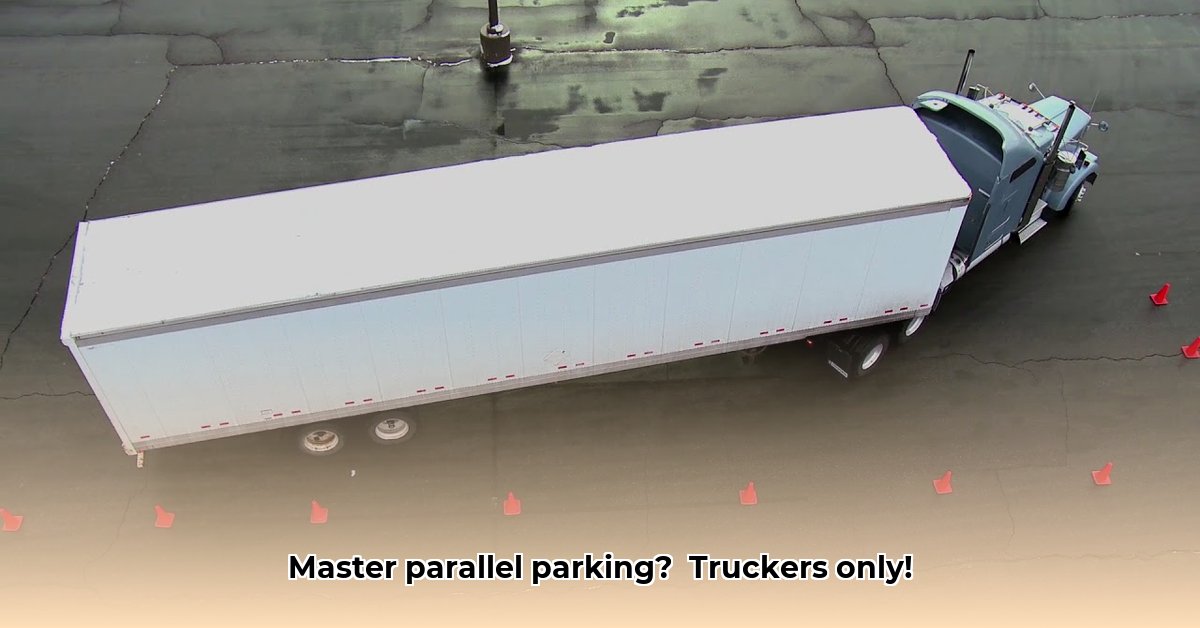
Parallel Parking: A Critical CDL Skill
Mastering parallel parking is crucial for Commercial Driver's License (CDL) holders. It's not just about passing the test; it's about ensuring safety and efficiency on the road. This guide provides a step-by-step approach, empowering you to confidently navigate tight spaces. Successfully parallel parking a tractor-trailer requires precision, practice, and a thorough understanding of your vehicle's dimensions. Did you know that proficient parallel parking can significantly reduce fuel consumption and delivery times? For more detailed video tutorials, check out this helpful resource.
Prerequisites: Essential Skills and Knowledge
Before tackling parallel parking, ensure you're proficient in basic tractor-trailer operation. This includes smooth maneuvering, confident braking, and skillful use of mirrors. Understanding your vehicle's dimensions – length, width, and turning radius – is paramount. Think of it like building a house: a solid foundation is essential for a strong structure. A firm grasp of these fundamentals will significantly improve your success rate.
Step-by-Step Parallel Parking Guide: Straight-Line Approach
This method is ideal for larger spaces.
Find Your Spot: Locate a space at least 1.5 times the length of your rig. Position your truck parallel to the vehicle in front, leaving 2-3 feet of clearance (approximately one wheel's width).
Initial Turn: Turn your steering wheel fully to the right and begin backing up slowly. Use your mirrors constantly to monitor your position relative to the vehicles around you.
Alignment: As your trailer starts to straighten, gradually turn the wheel back to the center. Continue backing up, making small steering adjustments as needed to maintain alignment with the space.
Final Adjustment: Once the trailer is near the curb, make minor adjustments using small steering inputs to perfectly center your rig. A well-executed parallel park should leave approximately 1-2 feet of clearance on both sides.
Step-by-Step Parallel Parking Guide: Blind-Side Approach
This technique is more challenging, suitable for tighter spaces.
Initial Positioning: Position your truck so your cab mirrors are level with the rear bumper of the vehicle ahead. This precise positioning is key to success, so take your time.
The Reverse 'S': Begin reversing and gently turn the steering wheel to the left. Guide the trailer's rear into the space using your mirrors. The movement should resemble a backwards 'S', smoothly navigating the trailer into the spot.
Precision Movements: Once the trailer enters the space, start straightening out by turning your wheel to the right. This will center the trailer.
Final Adjustments: Make small corrections as needed to align the truck and trailer perfectly, checking your surroundings.
Troubleshooting Common Challenges
Several issues can arise during parallel parking. Here are some common problems and solutions:
Trailer Jackknifing: This happens when turning too sharply or backing up too quickly. Slow down, and make smoother, smaller adjustments to your steering.
Curb Contact: This usually means misjudging your position or over-correcting. Precise use of your mirrors and careful observation are crucial.
Alignment Issues: Maintain constant mirror checks. Misalignment often stems from inadequate mirror use or improper initial positioning. Slow down and reassess your position.
Practice and Refinement: The Key to Success
Consistent practice is essential. Find a safe, open area (preferably with cones or markers) to simulate different parking scenarios. Repetition is key to building muscle memory and confidence. Remember, even small, incremental improvements contribute to long-term success. "Practice isn't just about repetition; it's about conscious refinement," advises veteran driving instructor Martha Jones, from the National Truck Driving School.
Advanced Techniques: Expanding Your Skillset
Once comfortable with the basics, consider these advanced techniques:
Reference Points: Utilize lines or curbs as visual guides; consistent reference points enhance precision.
Trailer Variations: Practice with different trailer lengths to understand how their dimensions affect maneuverability. The longer the trailer, the greater the challenge.
Curved Parking: Adjust your approach and technique to account for the curve of the road.
Visual Aids: Enhancing Understanding
Supplement this guide with online videos demonstrating the parking process from various angles. Visual aids significantly improve comprehension and retention. Consider using videos showing the straight-line and blind-side approaches, paying close attention to the mirror usage and steering adjustments shown. Seeing how others manage these complex maneuvers can significantly improve your confidence.
Conclusion: Drive Safely, Drive Confidently
Mastering parallel parking takes dedication and consistent practice. However, the rewards – improved safety, efficiency, and increased confidence – are significant. Remember, safe driving practices are paramount, and this skill is a crucial element of that. Congratulations on taking the first step to becoming a more proficient and safer driver.